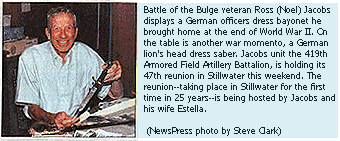419th battalion, that fought Battle
of the Bulge, holding reunion here
By Steve Clark
NewsPress Staff Writer

As a half-track driver in the 419th Armored Field Artillery Battalion of the 10th Armored Division in Patton's Third Army, Jacobs participated in the two-week long winter battle in the Ardennes Forest of Belgium and Luxembourg that smashed Hitler's grip on Western Europe.
On the eve of a reunion of the 419th Battalion, scheduled for this weekend in Stillwater, Jacobs spoke to the NewsPress about his war experiences in a kitchen table interview at his rural home near Perkins.
The Battle of the Bulge began December 16, 1944, with a massive German offensive designed to roll back Allied advances made after the Normandy invasion in June. It ended two weeks later in a rout for the Germans.
"They thought they was going to break us down and chase us plum out of there," said Jacobs, adding, however, that the enemy was no pushover.
"They were still fighting, fighting all the way. They fought and they fought hard."
Jacobs said that at times the battle was 360 degrees in every direction, such was when the German 6th Panzer Division laid siege to the Aillied-held town of Bastogne near the border of Belgium and Luxembourg. The 10th Armored Division helped form a shield around the city, foiling the enemy attack.
It was during the siege of Bastogne that the 101st Airborne Brigadier General Anthony C. McAuliffe when asked to surrender by Panzer Field Marshall Walter Model, sent his famous answer: "Nuts!"
Jacobs' battalion was awarded the Presidential Unit Citation in 1947 for its "superior technical ability and undaunted courage" during the Battle of the Bulge, so named for its bulging appearance on the map.
The citation reads in part: "Fighting without rest 24 hours a day, the battalion delivered fire in support of hard-pressed infantry. ...In the face of great odds, (it) played a major role in containing the hostile offensive against the city of Luxembourg and in protecting other important installations and terrain against the fanatical German attacks."
"Yes and no", Jacobs replied when asked of he felt lucky to survive the war.
"Where I was back in the artillery, I was back where it was more or less not being shot at by rifles. It was more or less mortars or howitzers that would get us. So I was fairly more safe. We only lost I think six or seven men."
The Germans favored a high-velocity armor-piercing shell known simply as the "88" while the Americans used the larger, slower 105mm Howitzer, said Jacobs.
"Ours we could lob, and we could get them places that they couldn't," he added.
"We could get behind a bunch of trees and we had more protection. You could stand by the tank and see that—boom!—traveling through the air."
Asked if he had any other souvenirs, Jacobs disappeared down the hall and returned a few moments later carrying a Nazi officer's dress saber, the guard topped by a lion's head with jewels for eyes; and a dress bayonet, the brightly polished blade etched with German script and an eagle perched atop a swastika.
Jacobs produced a black and white photo showing a young G.I. applying the finishing touches to a snowman sporting a Hitler-like moustache.
The winter scene, captured on film by a news photographer, was Luxembourg, Dec. 22, 1944; the soldier was Cpl. Noel Ross "Jake" Jacobs.
"I was wondering how I was going to get him to make my picture, so I built a snowman," said Jacobs. Though the plan worked, the picture never was published (until now).
The photographer did, however, mail the picture to Jacob's wife, Estella, who was busy building war planes at the Douglas aircraft plant in Tulsa.
To make the snowman's eyes, mouth and moustache, Jacobs was forced to use the only medium available that was dark enough and not frozen: cow manure.
The corporal's job with the battalion was to drive an officer's half track--called an 'exec-track'--for his lieutenant, Joseph Gebhardt. Jacobs said he shook hands with the man in Germany at the end of the war. "I lost him and never heard from him anymore," Jacobs said. "1945 was the last time I'd seen him, and I've wondered about him all these years, what's happened to him.
He said he ran into another lieutenant (Malcolm Cohen) recently who had known Gebhardt and thought he lived in New York. Jacobs started dialing. New York information turned up a name and he found himself talking to Gebhardt's youngest son's wife on the phone. She told him he died in 1965.
"Fifty-some years I was wondering where he was at and everything, and within 15 minutes from the time I started calling I found him," he said.
The kicker; Lt. Gebhardt's (oldest) son, now in his mid 40's, is in town for the 419th Battalion reunion, and looking forward to hearing all about his dad's wartime exploits. Nobody is in a better position than Jacobs himself.
The 47th annual reunion of the 419th Armored Field Artillery Battalion will run through Sunday at the Best Western.
The reunion, which was last held in Stillwater 25 years ago, is being hosted by Jacobs.